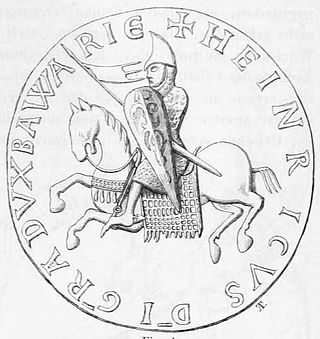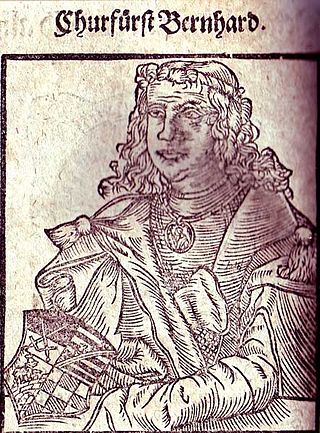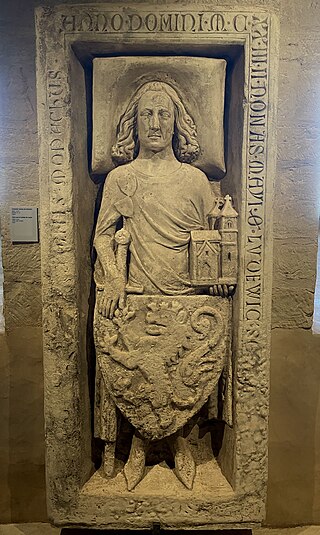
Lothair III, sometimes numbered Lothair II and also known as Lothair of Supplinburg, was Holy Roman Emperor from 1133 until his death. He was appointed Duke of Saxony in 1106 and elected King of Germany in 1125 before being crowned emperor in Rome. The son of the Saxon count Gebhard of Supplinburg, his reign was troubled by the constant intriguing of the Hohenstaufens, Duke Frederick II of Swabia and Duke Conrad of Franconia. He died while returning from a successful campaign against the Norman Kingdom of Sicily.

Henry Raspe was the Landgrave of Thuringia from 1231 until 1239 and again from 1241 until his death. In 1246, with the support of the Papacy, he was elected King of Germany in opposition to Conrad IV, but his contested reign lasted a mere nine months.

Henry II, called Jasomirgott, a member of the House of Babenberg, was Count Palatine of the Rhine from 1140 to 1141, Duke of Bavaria and Margrave of Austria from 1141 to 1156, and the first Duke of Austria from 1156 until his death.

Conrad was the landgrave of Thuringia from 1231 to 1234 and the fifth Grand Master of the Teutonic Order from 1239 to 1240. He was the first major noble to join the military order.

Hermann I, Landgrave of Thuringia and Count Palatine of Saxony, was the second son of Louis II, Landgrave of Thuringia, and Judith of Hohenstaufen, the sister of Emperor Frederick Barbarossa.

Louis IV the Saint, a member of the Ludovingian dynasty, was Landgrave of Thuringia and Saxon Count palatine from 1217 until his death. He was the husband of Elizabeth of Hungary.

Gertrude of Süpplingenburg was Duchess of Bavaria, Margravine of Tuscany, and Duchess of Saxony by marriage to Henry X, Duke of Bavaria, and Margravine of Austria and Duchess of Bavaria by marriage to Henry II, Duke of Austria. She was regent of Saxony during the minority of her son Henry the Lion in 1139–1142.
Theodoric I, called the Oppressed, was the Margrave of Meissen from 1198 until his death. He was the second son of Otto II, Margrave of Meissen and Hedwig of Brandenburg.
Ulric II was the Margrave of Istria from 1098 until circa 1107 and Carniola from 1098 until his death. He was the second son of Ulric I and Sophia, a daughter of Bela I of Hungary. He was thus of royal blood.
Otto II, the Rich, a member of the House of Wettin, was Margrave of Meissen from 1156 until his death.

The Ludovingians or Ludowingians were the ruling dynasty of Thuringia and Hesse during the 11th to 13th centuries.

Bernhard, a member of the House of Ascania, was Count of Anhalt and Ballenstedt, and Lord of Bernburg through his paternal inheritance. From 1180 he was also Duke of Saxony.
The Duchy of Thuringia was an eastern frontier march of the Merovingian kingdom of Austrasia, established about 631 by King Dagobert I after his troops had been defeated by the forces of the Slavic confederation of Samo at the Battle of Wogastisburg. It was recreated in the Carolingian Empire and its dukes were appointed by the king until it was absorbed by the Saxon dukes in 908. From about 1111/12 the territory was ruled by the Landgraves of Thuringia as Princes of the Holy Roman Empire.
Albert II was a member of the House of Ascania who ruled as the margrave of Brandenburg from 1205 until his death in 1220.
Herman II, Count of Weimar-Orlamünde was a member of the House of Ascania. He ruled the County of Weimar-Orlamünde from 1206 until his death.

Matilda of Andechs was a daughter of Margrave Berthold I of Istria and his first wife, Hedwig of Dachau-Wittelsbach, daughter of the Bavarian Count palatine Otto IV of Scheyern.

Ludwig II, Landgrave of Thuringia, nicknamed Louis the Iron.
Hedwig of Gudensberg, also known as Hedwig of Hesse (1098–1148) was German regent: she served as regent of Thuringia during the minority of her son Louis II from 1140.

Louis the Springer, sometimes called Louis the Jumper or Louis the Leaper, was a German nobleman and count in Thuringia from 1080 until his death. Little is known about him, although he is mentioned in many legends. He was a prominent opponent of the Salian emperors Henry IV and Henry V during the Investiture Controversy.

Louis III, nicknamed Louis the Pious or Louis the Mild was a member of the Ludowingians dynasty who ruled as Landgrave of Thuringia from 1172 until his death.













